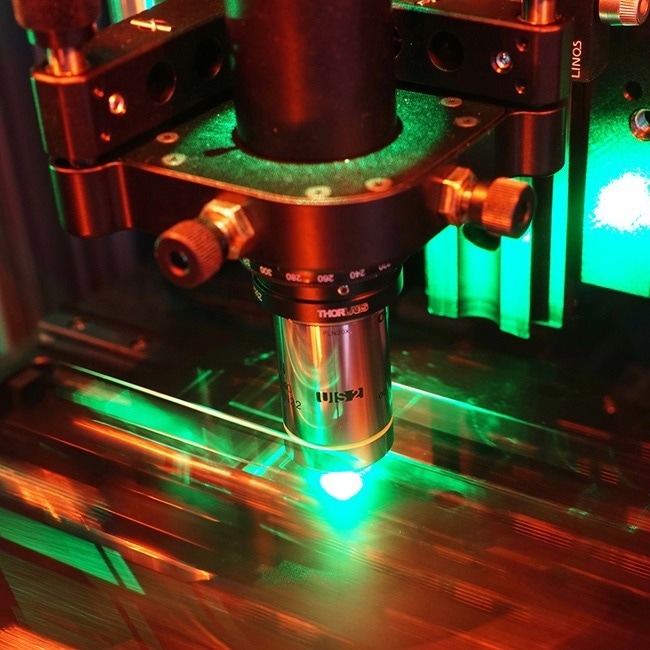Reviewed by Lexie CornerMar 5 2024
Scientists have devised an innovative method for managing and altering optical signals through the incorporation of a liquid crystal layer into waveguides formed using direct laser writing.
 Researchers embedded a liquid crystal layer into a waveguide created with direct laser writing (pictured). The resulting hybrid device can change the polarization of light traveling through the waveguide. Image Credit: GRK 2101, Friedrich Schiller University Jena
Researchers embedded a liquid crystal layer into a waveguide created with direct laser writing (pictured). The resulting hybrid device can change the polarization of light traveling through the waveguide. Image Credit: GRK 2101, Friedrich Schiller University Jena
These novel devices allow for the electro-optical regulation of polarization, potentially paving the way for advanced chip-based technologies and intricate photonic circuits built on femtosecond-written waveguides.
Laser writing of waveguides and electro-optical modulation via liquid crystals has not been combined in this way before. The hope is that this technology could be used to create a new class of integrated photonic devices that can process large amounts of information for data centers and other data-intensive applications.
Alessandro Alberucci, Postdoctoral Researcher, Friedrich Schiller University Jena
The scientists detailed in the journal Optical Materials Express the process of developing a customizable wave plate within a fused silica waveguide. By applying voltage to the liquid crystal, the molecules undergo rotation, thereby altering the polarization of light passing through the waveguide. Through their experiments, the researchers successfully showcased complete modulation of optical polarization at two distinct visible wavelengths.
Our work paves the way to integrating new types of optical functions into the whole volume of a single glass chip, enabling compact 3D photonic integrated devices that weren’t possible previously. The unique 3D nature of femtosecond-written waveguides could be used to create new spatial light modulators where each pixel is separately addressed by one waveguide. The technology could also find application in the experimental realization of dense optical neural networks.
Alessandro Alberucci, Friedrich Schiller University Jena
Bringing Two Key Technologies Together
Unlike alternative techniques, femtosecond lasers can inscribe waveguides deep within a material rather than just on the surface. This makes it a viable method for increasing the quantity of waveguides on a single chip. The process entails concentrating a powerful laser beam within a transparent material. Once the optical intensity reaches a certain level, the beam alters the material when exposed, effectively functioning as a precise micrometer pen.
Alberucci added, “The most important shortcoming of using femtosecond laser writing technology to create waveguides is the difficulty in modulating the optical signal in these waveguides. Since a complete communication network needs devices capable of controlling the transmitted signal, our work explores new solutions to overcome this limitation.”
In their latest publication, the researchers integrated two core photonic technologies by incorporating a liquid crystal layer within a waveguide. As the beam moves through the waveguide and reaches the liquid crystal layer, its phase and polarization are altered upon the application of an electric field. Subsequently, the modified beam continues through the waveguide’s second segment, propagating a beam with modulated characteristics.
The hybridization permits access to the advantages of both technologies in the same device: a large concentration of light due to the guiding effect, and a large degree of tunability associated with liquid crystals. This research leads the way to using liquid crystal properties as a modulator in photonic devices that have waveguides embedded in their whole volume.
Alessandro Alberucci, Friedrich Schiller University Jena
Benefits of the Hybrid Approach
In previous studies, the modulation of optical signals in femtosecond laser-written waveguides was accomplished by heating specific areas of the waveguide. However, recent research utilizes liquid crystals to manipulate the polarization directly, enabling more precise control.
Alberucci stated, “Our approach has several potential advantages: lower power consumption, the possibility to address single waveguides in the bulk independently, and less crosstalk between adjacent waveguides.”
The researchers tested the devices by injecting laser light into the waveguide and adjusting the voltage applied to the liquid crystal layer. This modulation of light resulted in the measured polarization at the output aligning with the predictions made by the theory. The integration of the liquid crystal with the waveguides did not alter the modulation properties of the liquid crystals.
The researchers emphasize that this study serves as a mere proof of concept, indicating that further research is necessary before the technology can be deemed suitable for practical use. One area of improvement is the need to enable independent control over each waveguide, as the current device only modulates all waveguides in the same manner.
Journal Reference:
Lammers, K., et al. (2024) Electro-optical control of polarization in femtosecond-laser written waveguides using an embedded liquid crystal cell. Optical Materials Express. doi:10.1364/OME.507230.